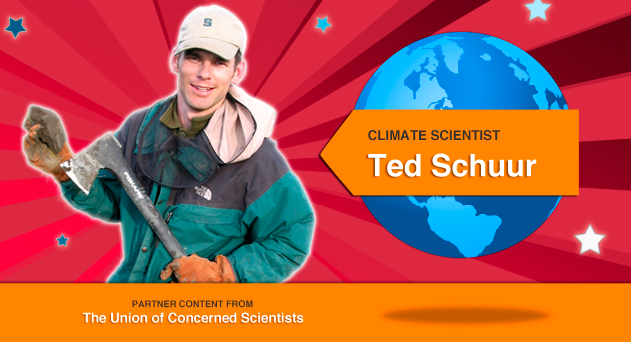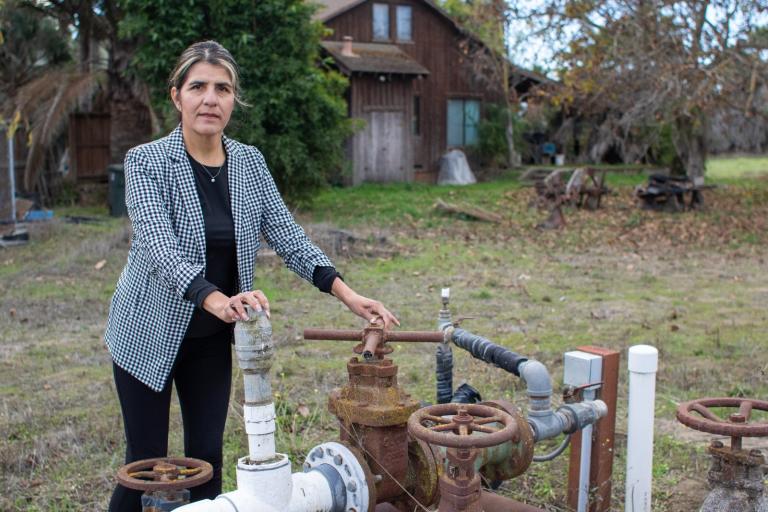Springtime, for most of us in northern temperate climes, is a welcome season of blooming plants, longer days, and warmer temperatures. But for Ted Schuur, an ecologist at the University of Florida, the season has different connotations. For Schuur, spring means a new season of exploration and adventure on the geographic and scientific frontier, where he is trying to answer a question of immense importance for our warming planet: How much carbon is being released by the thawing of the Arctic’s so-called permafrost?

Permafrost is the frozen soil, water, and rock that, astonishingly, covers nearly one quarter of all the exposed land surface in the Northern Hemisphere. Trapped within this frozen ground is a vast amount of carbon, which has accumulated from the partial decomposition of plants and animals over tens of thousands of years. Frozen in permafrost, the organic matter is mostly stable, decaying very, very slowly. But as air and permafrost temperatures rise, the organic material breaks down more rapidly and releases carbon into the atmosphere at a higher rate. Schuur’s research seeks to find out precisely how much carbon is released in this process and how rapidly the thawing is occurring.
The stakes of this research could hardly be higher. Schuur and his colleagues have estimated that the northern permafrost contains nearly 1.7 trillion tons of carbon. That’s roughly twice the total amount of carbon in the atmosphere today. If even 20 percent of the northern permafrost thaws, Schuur explains, it could release as much carbon into the atmosphere as humans have emitted by burning fossil fuels since the beginning of the Industrial Revolution.
Just how much carbon will the permafrost release? To understand the process more precisely, each year around this time, as soon as school ends, Schuur and his family pack up their home and make the trek to a rustic cabin in Alaska with no running water. Schuur has spent each of the past 14 summers closely monitoring the region’s permafrost. “In some sense,” he says, “my research allows me to live out my childhood dream of camping out as part of my job.”
Growing up in Michigan, Schuur says, he was always interested in nature. He fondly recalls his years as a Boy Scout, and he loved going to “insect camp,” where he was encouraged to catch bugs and learn about biology. Later, “in my graduate work,” he explains, “I focused on tropical rainforests, where I became fascinated by the ecological dynamics of the carbon cycle” — the way carbon moves between the soil, living plants, animals, and all forms of life as well as the ocean and the atmosphere. Ultimately, Schuur’s fascination with the carbon cycle led him to study the Arctic. “It was a case of applied science,” he says. “The simple fact is, exchanges of carbon in Earth’s northernmost regions have a potential for particularly large effects on the planet’s climate.”
In one ongoing study of thawing permafrost, Schuur’s research team makes detailed measurements at dozens of small, open-topped research chambers set up in the Alaskan wilderness. Each chamber is less than two feet tall — but large enough to enclose the typically small tundra vegetation. By lowering the station’s moveable roof for two minutes at a time following a precise protocol, Schuur measures the amount of carbon that is taken up and released at each location at all times of the day and night throughout the spring and summer and fall.
Schuur’s latest efforts takes his past observational research one step further. His research team has begun to artificially warm some of the plots, both to test his past results and to more precisely predict what to expect as further warming occurs.
In Schuur’s research, two key questions have important implications for global warming trends. The first is: To what extent does the release of carbon follow a linear trajectory as permafrost warms? The top layer of permafrost is “active,” in that it thaws and freezes seasonally and is naturally more susceptible to changes in surface temperature. Schuur is trying to understand whether certain temperatures or conditions at the surface might trigger disproportionately greater releases of carbon from the layers below.
He also studies the form the carbon takes when it is released, a very important factor. Organic matter that degrades with plenty of air supply emits primarily carbon dioxide. But when soil is very wet or under water where there is little available oxygen, decomposing organic materials give off methane gas in combination with carbon dioxide. The composition of the gases released makes a huge difference, because methane, though much less abundant in the atmosphere than carbon dioxide, traps some 25 times more heat than carbon dioxide when compared over a century timescale. Carbon released as methane lasts in the atmosphere for about a decade before converting to carbon dioxide, which continues to trap heat for many more decades, some of it lingering for many centuries. “The distinction [between the two gases] gives us some very important information about the impact of permafrost carbon on the pace of climate change,” Schuur says, “but the fact is, there is going to be a significant impact whether carbon is released as carbon dioxide or as methane.”
Schuur’s research takes on added urgency because global warming is occurring twice as fast in the Arctic as most places on Earth. In Alaska you don’t have to be a scientist like Schuur to see the effects firsthand. Average temperatures in Alaska have risen by 3 to 5 degrees Fahrenheit over the past 30 years.
As greenhouse gases — either carbon dioxide or methane gas — are released into the atmosphere from permafrost, scientists predict a vicious cycle: The gases will trap heat and warm the air, thawing more permafrost, releasing more carbon and further heating the planet. Scientists call this a “positive feedback” because it speeds up the pace of change. But for the current pattern of life on Earth, there is nothing positive about it.
Schuur’s work is crucial because it helps us understand more precisely the impact of thawing permafrost on the pace of climate change. It is important to note that while the exact extent and speed of the changes to come are not known, there is no uncertainty about the general warming trend. As a ballpark figure, Schuur says “it is reasonable to assume that 100 billion tons of carbon and perhaps more could be released into the atmosphere from thawing permafrost this century.” That amount, equal to about a third of the total carbon emissions humans have caused so far, is cause for substantial concern.
But, despite the scale of the looming thaw, Schuur says he sleeps well at night.
“The way I see it,” he says, “thawing permafrost carbon is a huge unknown process already underway, and my mission is to tell the world everything I can about it. My goal is not to scare people but to allow us all to look into the future with as much information as possible. As immense as the consequences may be, I feel my work has a positive purpose. I do believe that the more we know, the more control we have over our future.”
This is the 17th installment of America’s Climate Scientists: A series from the Union of Concerned Scientists. Click here to read all the climate scientist profiles.
The Union of Concerned Scientists is currently leading a campaign to elevate the voices of climate scientists and educate the public about the overwhelming scientific evidence for human-caused global warming. Learn how you can get involved at www.ucsusa.org/evidence
.



